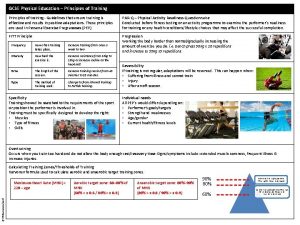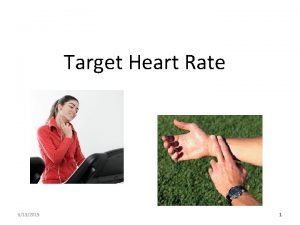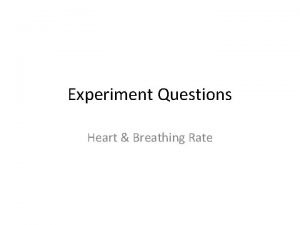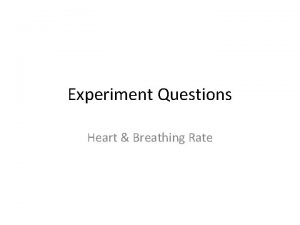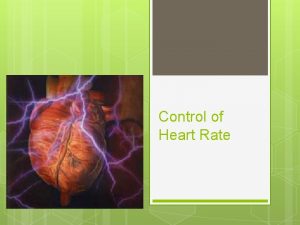Five Heart Rate Training Zones Module 3 IPEP












- Slides: 12

Five Heart Rate Training Zones Module 3 IPEP Chagrin Falls High School

Levels of the Cardiovascular Fitness Pyramid You can also work in five different levels of intensity for different periods of time to train for different types of results. Levels are selected on what your own personal goals are during a cardiovascular workout. Red Zone 90 -100% of MHR 1 Time/Week 1 -5 min Anaerobic Zone 90 -100% of Maximum Heart Rate 2 Times/Week 5 -10 min Aerobic Zone 70 -85% of Maximum Heart Rate 3 Times/Week 15 -30 min Healthy Heart Zone 50 -70% of Maximum Heart Rate 4 -5 Times/Week 30 min Weight Management Zone 40 -50% of Maximum Heart Zone 6 Times/Week 60 min

Level 1: Weight Management Zone On the bottom of the pyramid is Weight Management/Maintenance Zone. This zone uses fat calories rather than carbohydrate calories for its fuel and as a result helps individuals lose weight.

Weight Management Zone Frequency – 6 times per week 10– 12 RPE Intensity = 40%– 50% of MHR Activities: walking, recreational swimming, biking, volleyball � Time= 60 minutes � � � Calculate: What would your weight management zone be? _________ BPM

Level 2: Healthy Heart Zone This zone strengthens the heart and gives it the opportunity to work at its optimum level with a steady, pain-free, moderate pace. This workout also allows you to include circuit or interval activities for a shorter period of time.

Healthy Heart Zone Frequency – 4– 5 times per week � 12– 14 RPE � Intensity – 50%– 70% of MHR � Activities: moderate movement such as slow jogging, biking, rollerblading � Time – 30 minutes � � Calculate: What would your healthy heart zone be? ____-_____ BPM

Level 3: Aerobic Zone This zone benefits both the heart and the respiratory system. You will enhance your body’s ability to move oxygen to and carbon dioxide away from the muscle being used. You may feel some discomfort. Your breathing will be strong, and you will feel the exertion on your body.

Aerobic Zone � Frequency – 3 times per week � 14– 17 RPE � Intensity = 70%– 85% of MHR � Activities: moderate to vigorous activities, treadmill, ski machine, basketball, soccer � Time = 20– 30 minutes Calculate: What would your Aerobic training zone be? ____-_____ BPM

Level 4: Anaerobic Zone This zone allows you to cross over and begin anaerobic training (without oxygen). There is no exchange between oxygen and carbon dioxide in the muscles when you are anaerobic. The main benefit of this training is that you increase your body’s ability to metabolize lactic acid, thus allowing your muscles to train harder before crossing into the pain of lactate accumulation and oxygen debt. The intensity of this training is hard. You will experience tired muscles, heavy breathing , and fatigue. This level is used if you are training for competition. This workout is not for untrained or out-of-condition individuals.

Anaerobic Zone Frequency – 2 times per week � 16– 19 RPE � Intensity – 80%– 90% of MHR � Activities: sprints, some types of weight lifting � Time – 5– 10 minutes � � Calculate: What would your Anaerobic zone be? ____-_____ BPM

Level 5: Red Zone On the top of the pyramid is the Red Zone, which is only for individuals in training who are extremely fit. With this training, you will have crossed into the anaerobic threshold and will be working in oxygen debt. The training is extremely difficult. Untrained individuals who participate in these workouts will suffer great discomfort and could suffer injury.

Red Zone � Frequency – 1 time per week � 18– 20 RPE � Intensity – 90%– 100% of MHR Activities: jumping or sprinting fast for short periods of time � Time= 1 -5 minutes �
 Ipep granada horarios
Ipep granada horarios Weather and climate video
Weather and climate video How do littoral zones differ from riparian zones?
How do littoral zones differ from riparian zones? Congestive heart failure zones for management
Congestive heart failure zones for management Btec sport exam
Btec sport exam Karvonen formula gcse pe
Karvonen formula gcse pe Training zones gcse pe
Training zones gcse pe C device module module 1
C device module module 1 Module 43 featured worksheet 1 fixed exchange rate policy
Module 43 featured worksheet 1 fixed exchange rate policy Five years have past five summers with the length
Five years have past five summers with the length Five of five
Five of five 5 elements and 5 senses
5 elements and 5 senses The devil damn thee black
The devil damn thee black





